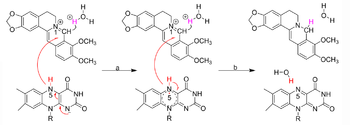Journal:Acta Cryst D:S2059798322008373
From Proteopedia
(Difference between revisions)

(New page: -) |
|||
| (17 intermediate revisions not shown.) | |||
| Line 1: | Line 1: | ||
| - | - | + | <StructureSection load='' size='450' side='right' scene='92/920253/Cv/7' caption=''> |
| + | ===Structural basis for the transformation of traditional medicine berberine by bacterial nitroreductase=== | ||
| + | <big>Hai-Ying Wen, Li-Bin Pan, Shu-Rong Ma, Xin-Yu Yang, Jia-Chun Hu, Hai-Fan Zhao, Zeng-Qiang Gao, Yu-Hui Dong, Jian-Dong Jiang, Yan Wang and Heng Zhang</big> <ref>doi: 10.1107/S2059798322008373</ref> | ||
| + | <hr/> | ||
| + | <b>Molecular Tour</b><br> | ||
| + | Crystal structure of bacterial nitroreductase (NR) NfsB in complex with the traditional medicine berberine (BBR) showed <scene name='92/920253/Cv/5'>BBR binds into the active pocket at the NfsB dimer interface</scene>. The two subunits of NfsB dimer are shown in green and cyan, respectively. The molecules FMN, BBR and DMSO are shown as state blue, magenta and yellow ball-and-sticks, respectively. BBR is mainly stabilized by <scene name='92/920253/Cv/3'>π-stacking interactions with both neighboring aromatic residues and the cofactor FMN</scene>. Several well-ordered <scene name='92/920253/Cv/4'>water molecules neighboring BBR in the active site</scene> probably donate protons in conjunction with electron transfer from FMN for BBR reduction. Water molecules are shown as red spheres. <scene name='92/920253/Cv/6'>All berberine interactions</scene>. | ||
| + | [[Image:NRpathway.png|left|350px|thumb|A proposed mechanism of BBR-to-dhBBR conversion by bacterial NRs]] | ||
| + | {{Clear}} | ||
| + | <span class="bg-yellow"><span class="far fa-hand-point-right"></span> Remember to drag the structures with the mouse to rotate them.</span> | ||
| + | |||
| + | <b>References</b><br> | ||
| + | <references/> | ||
| + | </StructureSection> | ||
| + | __NOEDITSECTION__ | ||
Current revision
| |||||||||||
This page complements a publication in scientific journals and is one of the Proteopedia's Interactive 3D Complement pages. For aditional details please see I3DC.

